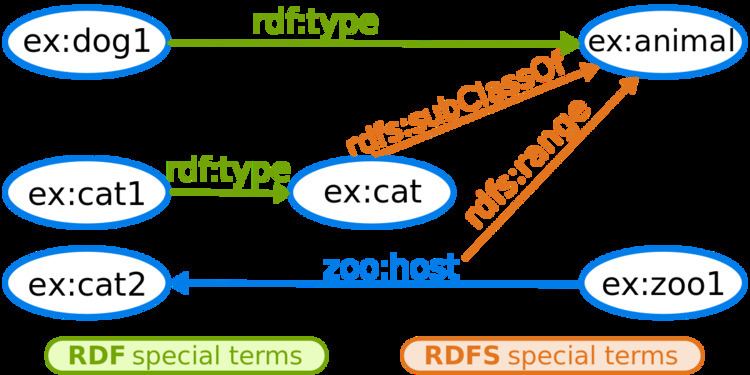Status Published Related standards | Base standards RDF | |
 | ||
Year started 1998; 19 years ago (1998) Editors Dan Brickley, Ramanathan V. Guha | ||
RDF Schema (Resource Description Framework Schema, variously abbreviated as RDFS, RDF(S), RDF-S, or RDF/S) is a set of classes with certain properties using the RDF extensible knowledge representation data model, providing basic elements for the description of ontologies, otherwise called RDF vocabularies, intended to structure RDF resources. These resources can be saved in a triplestore to reach them with the query language SPARQL.
Contents
- Main RDFS constructs
- Classes
- Properties
- Utility properties
- Examples of RDF Vocabularies
- RDFS entailment
- References
The first version was published by the World-Wide Web Consortium (W3C) in April 1998, and the final W3C recommendation was released in February 2004. Many RDFS components are included in the more expressive Web Ontology Language (OWL).
Main RDFS constructs
RDFS constructs are the RDFS classes, associated properties and utility properties built on the limited vocabulary of RDF.
Classes
A typical example of an rdfs:Class is foaf:Person in the Friend of a Friend (FOAF) vocabulary. An instance of foaf:Person is a resource that is linked to the class foaf:Person using the rdf:type property, such as in the following formal expression of the natural-language sentence : 'John is a Person'.
ex:John rdf:type foaf:Person
The definition of rdfs:Class is recursive: rdfs:Class is the class of classes, and so it is an instance of itself.
rdfs:Class rdf:type rdfs:Class
The other classes described by the RDF and RDFS specifications are:
Properties
Properties are instances of the class rdf:Property and describe a relation between subject resources and object resources. When used as such a property is a predicate (see also RDF: reification).
For example, the following declarations are used to express that the property ex:employer relates a subject, which is of type foaf:Person, to an object, which is of type foaf:Organization:
ex:employer rdfs:domain foaf:Person
ex:employer rdfs:range foaf:Organization
Given the previous two declarations, the following triple requires that ex:John is necessarily a foaf:Person, and ex:CompanyX is necessarily a foaf:Organization:
ex:John ex:employer ex:CompanyX
For example, the following declares that 'Every Person is an Agent':
foaf:Person rdfs:subClassOf foaf:Agent
Hierarchies of classes support inheritance of a property domain and range (see definitions in next section) from a class to its subclasses.
Utility properties
Examples of RDF Vocabularies
Popular RDF vocabularies represented in RDFS include:
RDFS entailment
An entailment regime defines by RDFs (,OWL, etc.) not only which entailment relation is used, but also which queries and graphs are well-formed for the regime. The RDFS entailment is a standard entailment relations in the semantic web.
For example, the following declares that 'Dog1 is an animal','Cat1 is a cat', 'Zoos host animals' and 'Zoo1 hosts the Cat2' :
ex:dog1 rdf:type ex:animalex:cat1 rdf:type ex:catzoo:host rdfs:range ex:animalex:zoo1 zoo:host ex:cat2But this graph is not well formed because the system can not guess that a cat is an animal. We have to add 'Cats are animals' to do a well-formed graph with :
ex:cat rdfs:subClassOf ex:animalHere is a correct example:
If your triplestore (or RDF database) implements the regime entailment of RDF and RDFS, the SPARQL query as follows (the keyword "a" is equivalent to rdf:type in SPARQL):
Gives the following result with cat1 in it because the Cat's type inherits of Animal's type:
